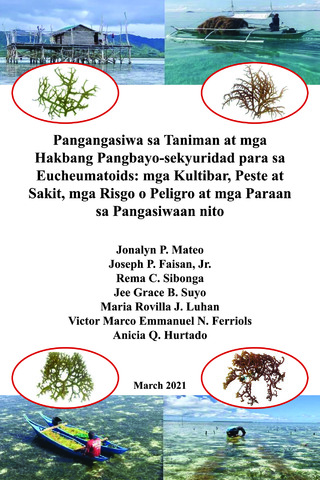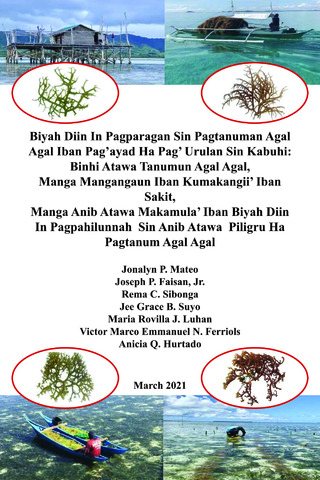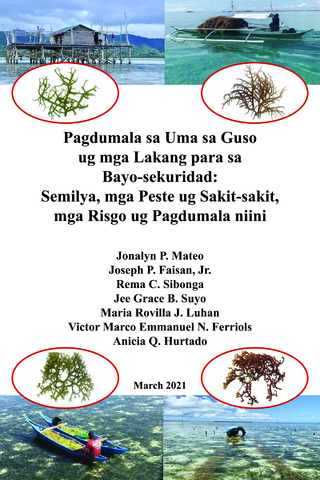| dc.contributor.author | Faisan, Jr., Joseph | |
| dc.contributor.author | Samson, Edcel Jed D. | |
| dc.contributor.author | Sollesta-Pitogo, Hananiah | |
| dc.contributor.author | Dayrit, Rheniel | |
| dc.contributor.author | Balinas, Vicente T. | |
| dc.contributor.author | de la Peña, Leobert D. | |
| dc.coverage.spatial | Guimaras | en |
| dc.coverage.spatial | Philippines | en |
| dc.date.accessioned | 2024-01-09T03:56:47Z | |
| dc.date.available | 2024-01-09T03:56:47Z | |
| dc.date.issued | 2024-01-08 | |
| dc.identifier.citation | Faisan, J. P., Samson, E. J. D., Sollesta-Pitogo, H. T., Dayrit, R., Balinas, V. T., & De La Peña, L. D. (2024). Seasonal growth, carrageenan properties, and resistance to disease and epiphytic pests between Kappaphycus alvarezii (Rhodophyta) var. Tambalang (brown) tissue-cultured and farm-sourced seaweeds. Journal of Applied Phycology. https://doi.org/10.1007/s10811-023-03164-z | en |
| dc.identifier.issn | 0921-8971 | |
| dc.identifier.uri | http://hdl.handle.net/10862/6512 | |
| dc.description.abstract | Growth performance (specific growth rate [SGR] and biomass yield), carrageenan properties (yield, viscosity, and gel strength), and disease and pest incidence were compared between Kappaphycus alvarezii var. tambalang (brown) tissue-cultured (TC) plantlets and farm-sourced (FS) seedlings. Seedlings used in the trials were propagules (4‒19 g pieces) and these were deployed on lines in sea cages over three separate runs of 60 days. The highest growth rate was recorded in TC plantlets and the SGRs were significantly higher (1.5‒6.5x) in TC than FS after Day of Culture (DOC) 15 (i.e., measurements taken every 15 days in each cycle). The carrageenan properties did not differ between treatments, with the exception of viscosity at DOC 45, where TC was higher than FS. “Ice-ice” disease (IID) was observed in both FS and TC in May‒June and August‒October at DOC 45 to 60, coinciding with changes in environmental conditions (i.e., dry‒wet and wet seasons). IID in FS had a moderate to very high incidence (31.2‒86.2%), while TC IID had a lower range of incidence (12.8‒60.6%). On the other hand, epiphytic filamentous algae (EFA) were observed only in August‒October with a low incidence (≤25%). However, EFA appeared earlier in FS than in TC. Taken together, these results highlight that tissue-cultured seaweeds had higher growth performance without compromising carrageenan quality and may be more resistant to health problems than farm-sourced seedlings. Studies should now assess the long-term viability of using tissue-cultured seaweeds over farm-sourced seedlings scaling to allow testing in standard farm settings, including the size of the initial seed. | en |
| dc.description.sponsorship | The study is supported by SEAFDEC/AQD with study code DP-01-S2020I. | en |
| dc.language.iso | en | en |
| dc.publisher | Springer | en |
| dc.subject | Kappaphycus alvarezii | en |
| dc.subject | Rhodophyta | en |
| dc.title | Seasonal growth, carrageenan properties, and resistance to disease and epiphytic pests between Kappaphycus alvarezii (Rhodophyta) var. tambalang (brown) tissue-cultured and farm-sourced seaweeds | en |
| dc.type | Article | en |
| dc.citation.spage | 1 | en |
| dc.citation.journalTitle | Journal of Applied Phycology | en |
| dc.subject.asfa | seaweeds | en |
| dc.subject.asfa | seaweed culture | en |
| dc.subject.asfa | growth | en |
| dc.subject.asfa | carrageenans | en |
| dc.subject.asfa | disease resistance | en |
| dc.subject.asfa | diseases | en |
| dc.subject.asfa | pesticides | en |
| dc.subject.asfa | pesticide resistance | en |
| dc.subject.asfa | aquaculture | en |
| dc.subject.asfa | tissue culture | en |
| dc.identifier.essn | 1573-5176 | |
| dc.identifier.doi | 10.1007/s10811-023-03164-z | |
| dc.subject.scientificName | Kappaphycus alvarezii | en |
| local.subject | Aquaculture | en |
| local.subject | Disease and pest | en |
| local.subject | Seaweed farming | en |
| local.subject | Tissue culture | en |



